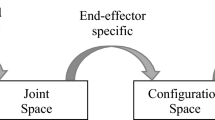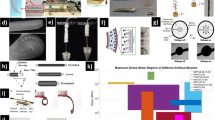Abstract
This paper reports on what differentiates the field of soft (i.e. soft-bodied) robotics from the conventional hard (i.e. rigid-bodied) robotics. The main difference centres on seamlessly combining the actuation, sensing, motion transmission and conversion mechanism elements, electronics and power source into a continuum body that ideally holds the properties of morphological computation and programmable compliance (i.e. softness). Another difference is about the materials they are made of. While the hard robots are made of rigid materials such as metals and hard plastics with a bulk elastic modulus of as low as 1 GPa, the monolithic soft robots should be fabricated from soft and hard materials or from a strategic combination of them with a maximum elasticity modulus of 1 GPa. Soft smart materials with programmable mechanical, electrical and rheological properties, and conformable to additive manufacturing based on 3D printing are essential to realise soft robots. Selecting the actuation concept and its power source, which is the first and most important step in establishing a robot, determines the size, weight, performance of the soft robot, the type of sensors and their location, control algorithm, power requirement and its associated flexible and stretchable electronics. This paper outlines how crucial the soft materials are in realising the actuation concept, which can be inspired from animal and plant movements.
Similar content being viewed by others
References
D. Rus and M. T. Tolley, Nature, 521, no. 7553, 467–475, (2015).
S. Kim, C. Laschi, and B. Trimmer, Trends in Biotechnology, 31:5, 287–294, (2013).
S. Bauer, S. Bauer-Gogonea, I. Graz, M. Kaltenbrunner, C. Keplinger, and R. Schwoediauer, Adv. Mater. 26, 149–162, (2014).
G. Alici, Editorial for Special Issue, http://www.mdpi.com/journal/robotics/special_issues/soft_robotic, accessed on May 20, 2016.
G. S. Chirikjian and J. W. Burdick, IEEE Transactions on Robotics and Automation, 11:6 , 781 – 793, (2005).
R. Kang, D. T. Branson, T. Zheng, E. Guglielmino, and D. G. Caldwell, Bioinspiration & biomimetics, 8:3, p. 036008, (2013).
R. J. Webster and B. A. Jones, The International Journal of Robotics Research, 29:13, 1661–1683, (2010).
R. Pfeifer, M. Lungarella, and F. Iida, Communications of ACM, 55:11, 76 – 87, (2012).
H. Hauser, A. J. Ijspeert, R. M. Fuchslin, R. Pfeifer, and W. Mass, Biological Cybernetics, 105, 355 –370, (2011).
R. Mutlu, G. Alici, M. in het Panhuis, and G.M, Spinks, Soft Robotics, 3:3, 120 –133, (2016).
Huber, J. E., N. A. Fleck and M. F. Ashby, The Royal Society: 2185, (1997).
T. V. Minh, T. Tjahjowidodo, H. Ramon, and H. V. Brussel, IEEE/ASME Transactions on Mechatronics, 16:1, 177–186, (2011).
ISO 8373:2012, Robots and robotic devices — Vocabulary, https://www.iso.org/obp/ui/#iso:std:iso:8373:ed-2:v1:en, accessed on June 7, 2017.
C. D. Onal, and D. Rus, Bioinspiration & Biomimetics, 8:2, 026003, 2013.
A. Albu-Schaffer, O. Eiberger, M. Grebenstein, S.Haddadin, C. Ott, T. Wimbock, S. Wolf and G. Hirzinger, IEEE Robot. Autom. Mag. 15, 20–30, (2008).
R. H. Ewoldt, Soft Robotics, 12–20, (2013).
G. Alici, R. Mutlu, D.Melling, E. W. H. Jager and K.Kaneto, In Electromechanically Active Polymers: A Concise Reference, edited by F. Carpi, Springer International Publishing, (2016).
C. Majidi, Soft Robotics, 5–11, (2013).
M. A. McEvoy and N. Correll, Science 347, DOI: 10.1126/science.1261689, (2015).
K. C. Galloway, K. P. Becker, B. Phillips, J. Kirby, S. Licht, D. Tchernov, R. J. Wood, and D. F. Gruber, Soft Robotics, 3, 23–33, (2016).
B. Mosadegh, P. Polygerinos, C. Keplinger, S. Wennstedt, R. F. Shepherd, U. Gupta, J. Shim, K. Bertoldi, C. J. Walsh and G. M. Whitesides, Advanced Functional Materials, 24, 2163–2170, (2014).
K. Suzumori, S. Iikura, and H. Tanaka, Robotics and Automation, Proceedings., 1991 IEEE International Conference on, 1622–1627, (1991)
S. Wakimoto, K. Suzumori, and K. Ogura, Advanced Robotics 25, 1311–1330, (2011).
R. F. Shepherd, A. A. Stokes, J. Freake, J. Barber, P. W. Snyder, A. D. Mazzeo, L. Cademartiri, S. A. Morin, and G, M. Whitesides, Angewandte Chemie International Edition, 52, 2892–2896, (2013).
R. Mutlu, G. Alici, and W. Li, IEEE/ASME Transactions on Mechatronics, 21, 1467–1478, (2016).
C. H. Nguyen, G. Alici, and R. Mutlu, ASME Journal of Mechanical Design, 136, 061009-061009-9, (2014).
H. Yuk, S. Lin, C. Ma, M. Takaffoli, N. X. Fang, and X. Zhao, Nature Communications, 8, 14230, 02/01/online. (2017).
H. Jin, E. Dong, G. Alici, S. Mao, X. Min, C. Liu, K. H. Low, and J. Yang, Bioinspiration & Biomimetics,11, 056012, (2016).
H.K. Yap, H.Y. Ng, C.-H. Yeow, Soft Robotics 3(3), 144–158, (2016).
G. Agarwal, N. Besuchet, B. Audergon and J. Paik, Sci. Rep. 6, 34224; doi: 10.1038/srep34224 (2016).
D. Yang, B. Mosadegh , A. Ainla , B. Lee , F. Khashai , Z. Suo , K. Bertoldi , and G. M. Whitesides, Advanced Materials, 27, 6323–6327, (2015).
S. E. Bakarich, R. Gorkin, M. in het Panhuis and G. M. Spinks, Macromol Rapid Commun, 36:1211–1217, (2015).
R. K, Katzschmann, A. D. Marchese, and D. Rus, In Proc. International Symposium on Experimental Robotics, (2014).
G. Sumbre, G. Fiorito, T. Flash, and B. Hochner, Curr. Biol. 16, 767–772, 2006.
C Zhang and C Rossi, Bioinspir. Biomim. 12 025005, (2017).
R. J. Full, In The Handbook of Comparative Physiology, W Dantzler, ed., 853–930, Oxford University Press, Oxford (1997).
W. M. Kier and K. K. Smith, Zoological Journal of the Linnean Society, 83, 307–324, (1985).
M. H. Dickinson, C. T. Farley, R. J. Full, M.A. R. Koehl, R. Cram and S. Lehman, Science, 288, I 00–106 (2000).
Madden, J. D. W., Vandesteeg, N. A., Anquetil, P., Madden, P. G., Takshi, A., Pytel, R. Z., Lafontaine, S. R., Wieringa, P., and Hunter, I. W., IEEE J. Oceanic Eng, 29 (3), 7006–28 (2004)
B. Trimmer, Soft Robotics. 4:1, 1–2. https://doi.org/10.1089/soro.2017.29011.bat, (2017)
A, Miriyev, K. Stack, K. and H. Lipson, Nat. Commun. 1–8, doi:10.1038/s41467-017-00685-3, (2017).
Meijer, K., Y. Bar-Cohen, and R. J. Full, SPIE Press, 25–46, (2003).
P. Polygerinos, N. Correll, S. A. Morin, B. Mosadegh, C. D. Onal, K. Petersen, M. Cianchetti, M. T. Tolley and R. F. Shepherd, Advanced Engineering Materials, DOI: 10.1002/adem.201700016, (2017).
G. Alici and R. W. Daniel, International Journal of Robotics and Automation, 11:2, 62--73, (1996).
F.L. Liu, G. Alici, B. Zhang, S. Beirne, and W. Li, Smart Materials and Structures, 24, 035015, (2015).
G. Alici, and N. N. Huynh, IEEE/ASME Transactions on Mechatronics, 12, 1, 73 -- 84, (2007).
B. Gaihre, G. Alici, G. M. Spinks, and J. M. Cairney, IEEE/ASME Journal of Microelectromechanical Systems, 21:3, 574 – 585, (2012).
W. H. Li, Y. Zhou, and T. F. Tian, Rheol Acta, 49, 733–740, DOI 10.1007/s00397-010-0446-9, (2010).
W.H. Li, H. Du and N.Q. Guo, Materials Science and Engineering A, 371, 9–15, (2004).
Author information
Authors and Affiliations
Corresponding author
Rights and permissions
About this article
Cite this article
Alici, G. Softer is Harder: What Differentiates Soft Robotics from Hard Robotics?. MRS Advances 3, 1557–1568 (2018). https://doi.org/10.1557/adv.2018.159
Published:
Issue Date:
DOI: https://doi.org/10.1557/adv.2018.159




